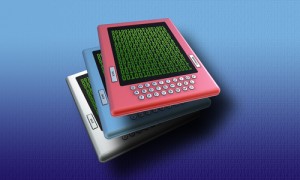
A massive study published last spring confirmed what many educators already know: having books in the home is as significant as socioeconomic status or parents’ educational level in determining the level of education children ultimately will attain.
Now, as more traditional book content goes digital and smart phones act as electronic readers, educators are left wondering whether technology will make achievement gaps even wider—or whether electronic books might act as a bridge for students traditionally hamstrung by family circumstances and other issues neither they nor their teachers control.
Conducted by university researchers in Nevada, California, and Australia, the study—published in the journal Research in Social Stratification and Mobility—found that having a 500-book library at home has as great an effect as having university-educated parents. The 20-year study analyzed data from 27 different countries.
In the United States, having books in the home pushes students an average of 2.4 years further in school; worldwide, the average is 3.2 years.
Other recent columns by Nora Carr:
Demographic shifts require changes in school communication
Having books in the home outweighed the education level of the parents, the father’s occupation, and the country’s GDP or political system. Children of parents with the least amount of education benefited the most.
Even having as few as 20 books in the home still had a significant impact, according the University of Nevada’s Mariah Evans, one of the study’s lead researchers. “You get a lot of ‘bang for your book,’” she said in a press release. “It’s quite a good return-on-investment in a time of scarce resources.”
For school officials, teachers, and community leaders struggling to bridge long-standing educational attainment and achievement gaps among different student groups, the implications are clear: We need to get more books in the home and into the hands of students.
Format might not matter. While many people still relish the smell of newly printed books or finding hidden treasures in library stacks, a small Massachusetts boarding school has shifted its media center to an all-digital format.
Now, instead of book stacks, the library at Cushing Academy in Ashburnham, Mass., features electronic books, Wi-Fi access, lounge-type seating, a coffee shop, more librarians—and, not surprisingly, more students.
With access to more and better books online and more comfortable surroundings, the school’s library has become a popular gathering place for students doing research and homework.
While cash-strapped public schools likely will skip the cappuccino machine, the concept of trading in 20,000 print books for greater comfort, robust databases, and online access to hundreds of thousands of high-quality books makes good economic sense.
Other recent columns by Nora Carr:
Demographic shifts require changes in school communication
Electronic books are cheaper to produce, catalog, access, and maintain than print tomes, while eReader costs are much less than laptop computers and netbooks. A $26 hardcover book costs $4.05 to produce vs. 50 cents for a $9.99 eBook, according to Newsweek magazine.
eBooks also are greener. While Newsweek estimates that the carbon emissions required to make 40 to 50 books equals that of one eReader device, one eReader can hold thousands of books. For eco-conscious students, stats like this might spur faster eReader adoption rates.
More importantly, eReaders and eBooks might help reignite a love of reading among today’s tech-oriented students.
Amazon.com, for example, estimates that Kindle users buy and read three times as many books as they did before buying the popular eReader device. Other surveys report similar results. Sales of eReaders and eBooks were brisk for the holidays, and industry experts expect eBook sales to double in 2011.
Because many classics are available electronically free of charge, and as school districts make more academic content available in digital formats for parents and students, putting a 500-book library in the palm of every child’s hand suddenly doesn’t seem so out of reach.
Detroit Public Schools, for example, is expanding its digital curriculum for students and staff. DPS is now streaming digital content from Discovery Education and Discovery Education Science, including virtual labs, simulations, video clips, and reading passages for secondary school students.
DPS teachers are accessing professional development digitally as well, tapping into multimedia presentations and lesson plans aligned with Michigan’s science standards for grades 6-12. The goal? Helping teachers differentiate instruction more successfully.
Similar efforts are under way in Indiana, Wisconsin, Connecticut, California, Ohio, New Jersey, Texas, and a host of other states.
While state governments and school districts pilot electronic book programs, some enterprising teachers and community volunteers are striking up partnerships with book publishers, bookstores, and online charities to put more reading resources in classrooms and student homes.
Other recent columns by Nora Carr:
Demographic shifts require changes in school communication
Programs like Adopt-a-School and Donors Choose, for example, fuel online donations to worthy classrooms and teacher-developed projects. And rotary clubs, professional associations, alumni organizations for fraternities and sororities, faith-based organizations, and other community groups are developing literacy-based partnerships with schools.
Armed with willing volunteers, these groups are more than willing to provide reading buddies, tutors, media center assistants and mentors, as well as free books, for schools serving poor neighborhoods. Someone simply needs to ask them to help—and provide some guidance, coordination, and an occasional thank you.
As the study, “Family scholarly culture and educational success: Books and schooling in 27 nations,” indicates, having 500 books in the home can make the difference between completing high school or dropping out, or graduating from college versus merely attending for a year a two.
If we want to bridge the educational divide between the haves and have-nots, reading—whether electronically or the old-fashioned way—is a great place to start.
Award-winning eSchool News columnist Nora Carr is the chief of staff for North Carolina’s Guilford County Schools.



Comments are closed.